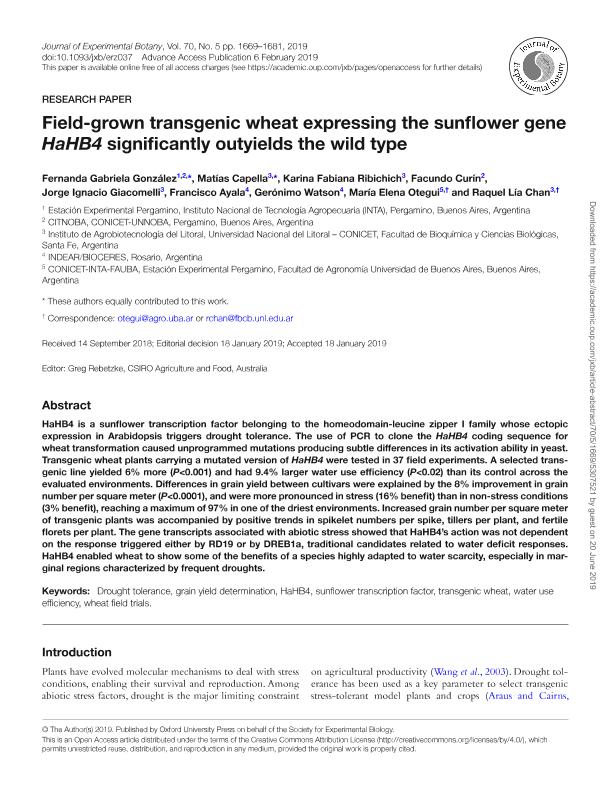Mostrar el registro sencillo del ítem
dc.contributor.author
González, Fernanda Gabriela

dc.contributor.author
Capella, Matias

dc.contributor.author
Ribichich, Karina Fabiana

dc.contributor.author
Curín, Facundo
dc.contributor.author
Giacomelli, Jorge Ignacio

dc.contributor.author
Ayala, Francisco
dc.contributor.author
Watson, Gerónimo
dc.contributor.author
Otegui, Maria Elena

dc.contributor.author
Chan, Raquel Lia

dc.date.available
2020-11-11T19:57:20Z
dc.date.issued
2019-03
dc.identifier.citation
González, Fernanda Gabriela; Capella, Matias; Ribichich, Karina Fabiana; Curín, Facundo; Giacomelli, Jorge Ignacio; et al.; Field-grown transgenic wheat expressing the sunflower gene HaHB4 significantly outyields the wild type; Oxford University Press; Journal of Experimental Botany; 70; 5; 3-2019; 1669-1681
dc.identifier.issn
0022-0957
dc.identifier.uri
http://hdl.handle.net/11336/118214
dc.description.abstract
HaHB4 is a sunflower transcription factor belonging to the homeodomain-leucine zipper I family whose ectopic expression in Arabidopsis triggers drought tolerance. The use of PCR to clone the HaHB4 coding sequence for wheat transformation caused unprogrammed mutations producing subtle differences in its activation ability in yeast. Transgenic wheat plants carrying a mutated version of HaHB4 were tested in 37 field experiments. A selected transgenic line yielded 6% more (P<0.001) and had 9.4% larger water use efficiency (P<0.02) than its control across the evaluated environments. Differences in grain yield between cultivars were explained by the 8% improvement in grain number per square meter (P<0.0001), and were more pronounced in stress (16% benefit) than in non-stress conditions (3% benefit), reaching a maximum of 97% in one of the driest environments. Increased grain number per square meter of transgenic plants was accompanied by positive trends in spikelet numbers per spike, tillers per plant, and fertile florets per plant. The gene transcripts associated with abiotic stress showed that HaHB4´s action was not dependent on the response triggered either by RD19 or by DREB1a, traditional candidates related to water deficit responses. HaHB4 enabled wheat to show some of the benefits of a species highly adapted to water scarcity, especially in marginal regions characterized by frequent droughts.
dc.format
application/pdf
dc.language.iso
eng
dc.publisher
Oxford University Press

dc.rights
info:eu-repo/semantics/openAccess
dc.rights.uri
https://creativecommons.org/licenses/by-nc-sa/2.5/ar/
dc.subject
DROUGHT TOLERANCE
dc.subject
GRAIN YIELD DETERMINATION
dc.subject
HAHB4
dc.subject
SUNFLOWER TRANSCRIPTION FACTOR
dc.subject
TRANSGENIC WHEAT
dc.subject
WATER USE EFFICIENCY
dc.subject
WHEAT FIELD TRIALS
dc.subject.classification
Agricultura

dc.subject.classification
Agricultura, Silvicultura y Pesca

dc.subject.classification
CIENCIAS AGRÍCOLAS

dc.subject.classification
Biotecnología Agrícola y Biotecnología Alimentaria

dc.subject.classification
Biotecnología Agropecuaria

dc.subject.classification
CIENCIAS AGRÍCOLAS

dc.title
Field-grown transgenic wheat expressing the sunflower gene HaHB4 significantly outyields the wild type
dc.type
info:eu-repo/semantics/article
dc.type
info:ar-repo/semantics/artículo
dc.type
info:eu-repo/semantics/publishedVersion
dc.date.updated
2020-11-11T12:32:16Z
dc.journal.volume
70
dc.journal.number
5
dc.journal.pagination
1669-1681
dc.journal.pais
Reino Unido

dc.description.fil
Fil: González, Fernanda Gabriela. Instituto Nacional de Tecnología Agropecuaria. Centro Regional Buenos Aires Norte. Estación Experimental Agropecuaria Pergamino; Argentina. Consejo Nacional de Investigaciones Científicas y Técnicas; Argentina
dc.description.fil
Fil: Capella, Matias. Consejo Nacional de Investigaciones Científicas y Técnicas. Centro Científico Tecnológico Conicet - Santa Fe. Instituto de Agrobiotecnología del Litoral. Universidad Nacional del Litoral. Instituto de Agrobiotecnología del Litoral; Argentina
dc.description.fil
Fil: Ribichich, Karina Fabiana. Consejo Nacional de Investigaciones Científicas y Técnicas. Centro Científico Tecnológico Conicet - Santa Fe. Instituto de Agrobiotecnología del Litoral. Universidad Nacional del Litoral. Instituto de Agrobiotecnología del Litoral; Argentina
dc.description.fil
Fil: Curín, Facundo. Universidad Nacional del Noroeste de la Provincia de Buenos Aires; Argentina
dc.description.fil
Fil: Giacomelli, Jorge Ignacio. Consejo Nacional de Investigaciones Científicas y Técnicas. Centro Científico Tecnológico Conicet - Santa Fe. Instituto de Agrobiotecnología del Litoral. Universidad Nacional del Litoral. Instituto de Agrobiotecnología del Litoral; Argentina
dc.description.fil
Fil: Ayala, Francisco. Consejo Nacional de Investigaciones Científicas y Técnicas. Centro Científico Tecnológico Rosario. Instituto de Agrobiotecnología de Rosario; Argentina
dc.description.fil
Fil: Watson, Gerónimo. Consejo Nacional de Investigaciones Científicas y Técnicas. Centro Científico Tecnológico Rosario. Instituto de Agrobiotecnología de Rosario; Argentina
dc.description.fil
Fil: Otegui, Maria Elena. Instituto Nacional de Tecnología Agropecuaria. Centro Regional Buenos Aires Norte. Estación Experimental Agropecuaria Pergamino; Argentina. Consejo Nacional de Investigaciones Científicas y Técnicas; Argentina. Universidad de Buenos Aires; Argentina
dc.description.fil
Fil: Chan, Raquel Lia. Consejo Nacional de Investigaciones Científicas y Técnicas. Centro Científico Tecnológico Conicet - Santa Fe. Instituto de Agrobiotecnología del Litoral. Universidad Nacional del Litoral. Instituto de Agrobiotecnología del Litoral; Argentina
dc.journal.title
Journal of Experimental Botany

dc.relation.alternativeid
info:eu-repo/semantics/altIdentifier/url/https://academic.oup.com/jxb/article/70/5/1669/5307521
dc.relation.alternativeid
info:eu-repo/semantics/altIdentifier/doi/https://doi.org/10.1093/jxb/erz037
Archivos asociados
